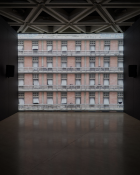Sunday, June 30 was the last day of this year’s İKSV Istanbul Music Festival, and the occasion was marked by a concert in which the Shanghai Philharmonic Orchestra and Fazıl Say performed at the Lütfi Kırdar Concert Hall. There were very few empty seats in the auditorium, though whether this was due to a desire to give the festival a rousing send-off or to the presence on the stage of Fazıl Say is difficult to determine, but I suspect the latter was uppermost in most people’s minds.
There seems to be a fashion among concert programmers for putting a concerto in the first half, and a symphony (or other purely orchestral work) in the second. This is the reverse of the traditional arrangement, and I have to say that I myself would have finished with the concerto, thus according Mr Say the honour of giving the final performance of the festival. It may be, however, that a more important consideration came into play, namely that many of the audience would want to be off as soon as they had witnessed him do his stuff. And indeed I have a certain amount of sympathy for this point of view: the work chosen to occupy the second half, Dvorak’s Symphony Number 6, is not exactly a colossus among symphonies – though the scherzo, a rhythmic and somewhat unbuttoned Slavic dance, is always stimulating. In my view, a selection of the composer’s Slavonic Dances might have been a better choice.
The Shanghai Philharmonic, conducted by Mr Liang Zhang, began with a work by the Chinese composer Ye Xiaogang entitled The Fading Gingko Biloba Tree. It made a satisfactory concert-opener, and I applaud the decision to add it to the programme. Going straight into the concerto without an overture of some kind would have been a mistake. The piece began with a flute solo in which the instrument hovered on one note, then gradually let it go flatter and flatter – a device similar to that occasionally heard in the music of the Japanese bamboo flute, the shakuhachi. We then had a demonstration of what happens when you make a long-held note go sharper and sharper. It made an unusual and quite entertaining start to the proceedings.
The beginning of The Fading Gingko Biloba Tree was the only truly original part of the whole work, however. The rest, although competently orchestrated, did not seem to have either a theme or any recognisable structure. There was a bit of this, and a bit of that, and then a pause, and then a bit of the other. At one point the composer treated us to a protracted discord, perhaps out of a desire to add variety. Unfortunately the chord he had chosen was nerve-bludgeoning rather than piquant. Nevertheless, the piece was short enough to allow its Oriental novelty to be appreciated and its blandness and lack of thematic material to be overlooked.
The description of Ye Xiaogang on the website of the International Society for Contemporary Music begins with the following sentence:
Composer Xiaogang Ye is a member of the 12th Chinese People's Political Consultative Conference, chairman of the Chinese Musicians’ Association, a member of the China Federation of Literary and Art Circles, vice president of the Central Conservatory of Music (CCOM), and a member of the Board of Directors of the China Film Association.
The Political Consultative Conference sounds like a heavy scene. But enough of politics – here is a video of a piece of music, rather than a piece of rhetoric, by him. Like many other of Ye Xiaogang’s compositions, his Gardenia for String Quartet and Pipa is named after a flower. I have to say his style isn’t my cup of tea, but it may be yours:
After the demise of the gingko biloba tree (which took ten minutes), we passed on to the meatier stuff – Beethoven’s Piano Concerto No 3 in C minor. Here are two accounts of the work. The first, by Jane Jones on the Classic FM website, gives you the background in brief. The second, from the Aspen Music Festival website, is much more detailed, and also has a description of the various movements. Unfortunately the author is not named, so I cannot acknowledge them. I was pleased to learn, that just like me, Beethoven was a big fan of Mozart’s Piano Concerto No 24 in C minor, K 491. I also found the account of Ignaz Seyfried’s misadventures as Beethoven’s page-turner at the first performance of his third piano concerto rather amusing.
The concert on June 30 was the first occasion on which I had heard Fazıl Say perform. He certainly made a strong initial impression, striding onto the stage wearing a long black smock somewhat reminiscent of an istanbulin – the variety of frock coat worn at the Ottoman court in the late 19th and early 20th centuries. In this concerto the soloist’s initial entry follows a long orchestral introduction. The next entry, an upward arpeggio (this begins at 04:15 in the recording below, by the way), was played by Mr Say in an unexpectedly hushed pianissimo that I thought a very nice touch, showing that in spite of all the razzmatazz built up around him he does indeed possess a high degree of musical sensitivity.
Mr Say has good articulation, too. His arpeggios had a most commendable lightness, and at one point he played a scale with a subtlety that really surprised and delighted me. No one else seems to have noticed that that particular upward scale can be played as if it were an impressionistic sweep from Debussy’s pen. Beethoven relies extensively on scales and arpeggios in his music, of course, so an ability to play them well, and in a variety of styles, cannot but be an advantage. Fazıl Say has just that skill.
The YouTube recording of the Beethoven concerto to which I have given a link below is a performance by the Portuguese virtuoso Maria João Pires. She is accompanied by the Orchestre National de France, conducted by Emmanuel Krivine. I particularly like the way she plays the second movement, with its bursts of fragile confidence followed by renewed descents into the abyss. After all, poor Ludwig’s life was not all sunshine and smiles, was it? The feminine delicacy of touch is there when needed in Ms Pires’s playing, but this lady also has the robustness surely needed for Beethoven:
To return to the concert at the Lütfi Kırdar, it was not long before I noticed that the sound produced by the Shanghai Philharmonic did not quite have the fullness one looks for in a Beethoven concerto. The string section, in particular, was somewhat too polite and restrained. Moreover, there was an element of imbalance in the woodwind department, where a loud bassoon seemed to dominate the other instruments. The lack of body in the overall timbre brought home to me once again how fortunate we are to have the Borusan and Tekfen orchestras in Istanbul – both are by and large up to European standards, and fully capable of blowing you backwards when they pull all the stops out. The companies sponsoring them deserve our gratitude: instead of spending their money financing orchestras, they could have decided to uplift our consciousness by building 50-storey tower blocks (entitled Nature Park Residences) on some priceless but now decimated piece of woodland, or sending us unwelcome advertisements on our telephones.
One cannot ignore the fact that Fazıl Say’s stage manner is extremely eccentric. When one of his hands is not engaged, he uses it to conduct the piano. Occasionally, he turns round to encourage the orchestra with a gesture or two (if I were conducting, I would be severely tempted to tell him to quit trespassing on my patch). He kept putting his free hand inside the piano, as if to determine whether or not the strings were actually there. And then, of course, there were the facial expressions. I noticed that a screwed-up face betraying only-just-tolerable anguish usually accompanies a passage in which he is playing well and with a high degree of emotional engagement. Some members of the orchestra were greatly amused by his antics, and I noticed more than one sly smile.
His cadenzas were non-traditional. In Beethoven’s time the soloist was expected to compose her or his own cadenzas, so in principle I have no quarrel with inventiveness in this department. However, even though Mr Say did indeed do the expected thing, in that he expanded on the main themes of the movement concerned, sometimes combining them quite cleverly, I am not sure that his inventions were always in harmony with commonly accepted notions of Beethoven’s style. There was one moment, indeed, when I thought what I was hearing was uncharacteristically twee, but I would still defend the pianist’s right to contribute something of her or his own to the concerto when the orchestra falls silent, the spotlight falls on the keyboard and the pianist either brings off a breathtaking display that has the multitudes eating out of her or his hand – or muffs it and looks up sheepishly into the faces of the firing squad, as the case may be.
Fazıl Say played Beethoven’s third piano concerto well. Occasionally, indeed, very well. That is something I need to make clear at this point, before I go on to express my opinion of the self-composed piece he played as an encore. This opinion will no doubt offend his fans, but even so I feel obliged to record the fact that it went on far too long, and that from time to time it caused me a good deal of unnecessary suffering.
The piece began with the pianist reaching into the instrument with one hand and holding a bunch of the strings, with the result that what he played with the other hand (a repeated sequence of three notes) had a suppressed, tinny sound – rather like a malfunctioning piano roll. The result could have been the music for a film in which some alien of unprepossessing appearance enters the house of an unsuspecting citizen at night, intent on Evil Deeds. Night (the piece by Fazıl Say played by the Jussen Brothers during their piano recital in Emirgan last October) made use of a similar technique, but was far more dramatic and more varied in the techniques it employed.
The mournful twanging that began Fazıl Say’s encore went on for a good five minutes, to be followed eventually by something that had me literally squirming in my seat – a kitsch ballad played over some soupy chords. This part of the piece was obviously designed to pummel the last drop of liquid out of recalcitrant tear ducts, but in reality only succeeded in making me wonder how any composer can possibly get away with things that are so overtly schmaltzy. Please, Mr Say, do try to learn a few more adventurous chords, and refrain from banging us over the head with that outsized soup-ladle!
Finally, he broke into a pianistic rendition of the song Üsküdara Giderken, a classic of the popular Turkish repertoire. This golden oldie was no doubt the stimulus that caused the audience to go berserk when at long last, and with obvious reluctance, the pianist tore himself away from the instrument. To give him his due, I have to say that the three-note introduction to the piece did make a good accompaniment to the song when he finally brought the two together. I did wish, however, that the audience had clapped, cheered and whistled after his Beethoven, which deserved a more rapturous reception than it actually received, rather than at the conclusion of a work that hardly merited more than a polite nod.
The programme notes for this concert spoke almost exclusively of Fazıl Say’s successes as a composer and had very little to say of his background as a pianist. In fact he received extensive training in pianism at some august institutions – first the Ankara State Conservatory, then the Robert Schumann Hochschule in Düsseldorf, and subsequently in Berlin. (These last two places must account for the fact that his playing shows a strong German influence, which of course is no bad thing.) But why ignore his abilities as a pianist, which are considerable, and present him to his listeners as a composer first and foremost? I found it most odd.
In the hope of redressing the balance somewhat, here is a video of him accompanying the violinist Patricia Kopatchinskaja in Beethoven’s Violin Sonata No 9, the 'Kreutzer'. You get some nice close-ups of his hands and facial expressions. Fazıl Say’s playing is a real treat in this piece, as is his coordination with the violinist. Indeed, his musicianship is outstanding throughout. Both performers appear to be really enjoying themselves, lapping up the drama. And why not?
The second half of the concert at the Lütfi Kırdar consisted of Antonin Dvořák’s Symphony No 6, sometimes referred to as the ‘Pastoral’. The account by Georg Predota on the Interlude website gives you a good background. I also like the allusions to Dvořák’s admiration for Brahms – which certainly comes over strongly in this work. What I find a little more questionable is the statement that once the first movement’s elegant initial theme is over, ‘rich melodic invention and free modulations determine the continuation’. I don’t think the rest of the material in this movement is particularly impressive, and in my opinion it certainly doesn’t justify its length (conductors may be forgiven for omitting the repeat, I feel). ‘Rich melodic invention’? Sorry, mate, I just don’t see it. I also think the writer could have made more of the third movement, a wonderfully rhythmic scherzo that is really quite wild. But anyway, Dvořák’s sixth symphony makes easy listening, and if in it you hear ‘the humor and pride, the optimism and passion of the Czech people come to life’, then good luck to you!
I agree with Richard Freed, another commentator, when he says (on the ‘Kennedy Center’ website) that the symphony ‘is by any standards one of the most ingratiating symphonies of its time. Expansiveness and geniality are its keynotes’. The expansiveness is something I think might have been kept a little more under control at times, but anyway here is a link to Mr Freed’s description:
The following performance of Dvořák’s Sixth, by the Czech Philharmonic under the baton of fellow-Czech Karel Ančerl (1908–1973) takes things at a fairly leisurely pace. I wish they had ramped up the metronome for the scherzo (which starts at 24:16) just half a notch, but the recording quality is good:
It is quite amazing that Ančerl (who was Jewish, and was sent to Auschwitz) survived the Second World War. The biography in an online article entitled Homage to Karel Ančerl says: ‘Ančerl stood at the threshold of a great artistic career [as a conductor]... [when] the war fatefully affected his life. Following the occupation of the republic [ie, Czechoslovakia], he was immediately released from his position, and on 16 November 1942 he was transported to Terezin [a concentration camp near Prague], where he took part in the well-known music-making there which took place in unbelievable circumstances; after two years he was transported to Auschwitz, where he lost his family but miraculously survived.’
The next recording of the symphony (by the Bayerische Rundfunk Sinfonieorchester) is of a performance conducted by Rafael Kubelík (1914–1996), a Czech icon who was the son of the celebrated violinist Jan Kubelík. This video has the score, which allows you to see just how the composer creates the syncopations in the scherzo (which begins at 25:13):[
The biography of Rafael Kubelík on the Bach Cantatas website says that although he did not have a particularly easy time in the Second World War, he survived it successfully by going into hiding. In 1944, ‘after various incidents, including one in which he declined to greet the Nazi Reichsprotektor Karl Hermann Frank with a Hitler salute – along with his refusal to conduct Wagner during the War – Kubelík “deemed it advisable to disappear from Prague and to spend a few months undercover in the countryside so as not to fall into the clutches of the SS or Gestapo”. One wonders how on earth he managed that feat.
The Shanghai Philharmonic gave us a very competent performance of the Dvořák, and were ably conducted – not just in the second half, but throughout the concert – by Liang Zhang, who was trained in Vienna and is also (apparently) a very capable pianist. The final encore was a piece showing strong Chinese musical influence. It used the pentatonic scale, and had lots of portando swoopings between notes. Even though the work chosen was somewhat subdued in tone, I applaud the decision to showcase the orchestra’s home culture.
And so it is time, now that the İKSV Istanbul Music Festival has come to a close, to express thanks to its worthy sponsors and to the İKSV itself for affording us Istanbulites the privilege of listening to performances by such a wide variety of excellent musicians. In particular I would like to thank the İKSV’s Ms Derya Bozcuk, who arranged strategically placed seats for me in both the Lütfi Kırdar and Hagia Eirene, and attended to my unreasonable requests with great courtesy and charm.
I have tried, in this piece, to get the accents on the Czech names right, and duly apologise for any omissions in this regard. Getting things right is something that, with my background in dictionary production, I have in the past spent a great deal of time trying to do. In this I have not always been successful, I have to say. On one occasion in 1977, I was seriously misled by the Turkish-English dictionary I carried with me as I crossed the border between Turkey and Greece at İpsala. At that time it was possible to walk over the bridge spanning the river dividing the two countries. Just before the midpoint of this bridge there was a sentry box in which two Turkish soldiers were on duty. A few yards further on, a Greek sentry box stood on the far side of a line painted across the road. As I passed the Turkish sentries one of them called out to me: “Hoşça kal!”
I should explain that this phrase actually means ‘remain pleasantly’, hoşça being the adverb form of the adjective hoş (‘pleasant’), and ‘kal’ being the familiar imperative form of the verb ‘kalmak’ (‘stay, remain’). I already knew what ‘hoş’ meant, but not having spent much time in Turkey up to that point I was mystified by the rest of the phrase. So I took out my dictionary and looked up what I took – mistakenly, as it turned out – to be the second of the two words, çakal. Imagine my surprise on finding that this word in fact means ‘jackal’! ‘Pleasant jackal? Why are they calling me that?’ I wondered.
And so, in the words of John Milton in his poem Lycidas,
At last he rose, and twitched his mantle blue:
Tomorrow to fresh woods, and pastures new.
The pastures new, in this case, are the İKSV Istanbul Jazz Festival.









